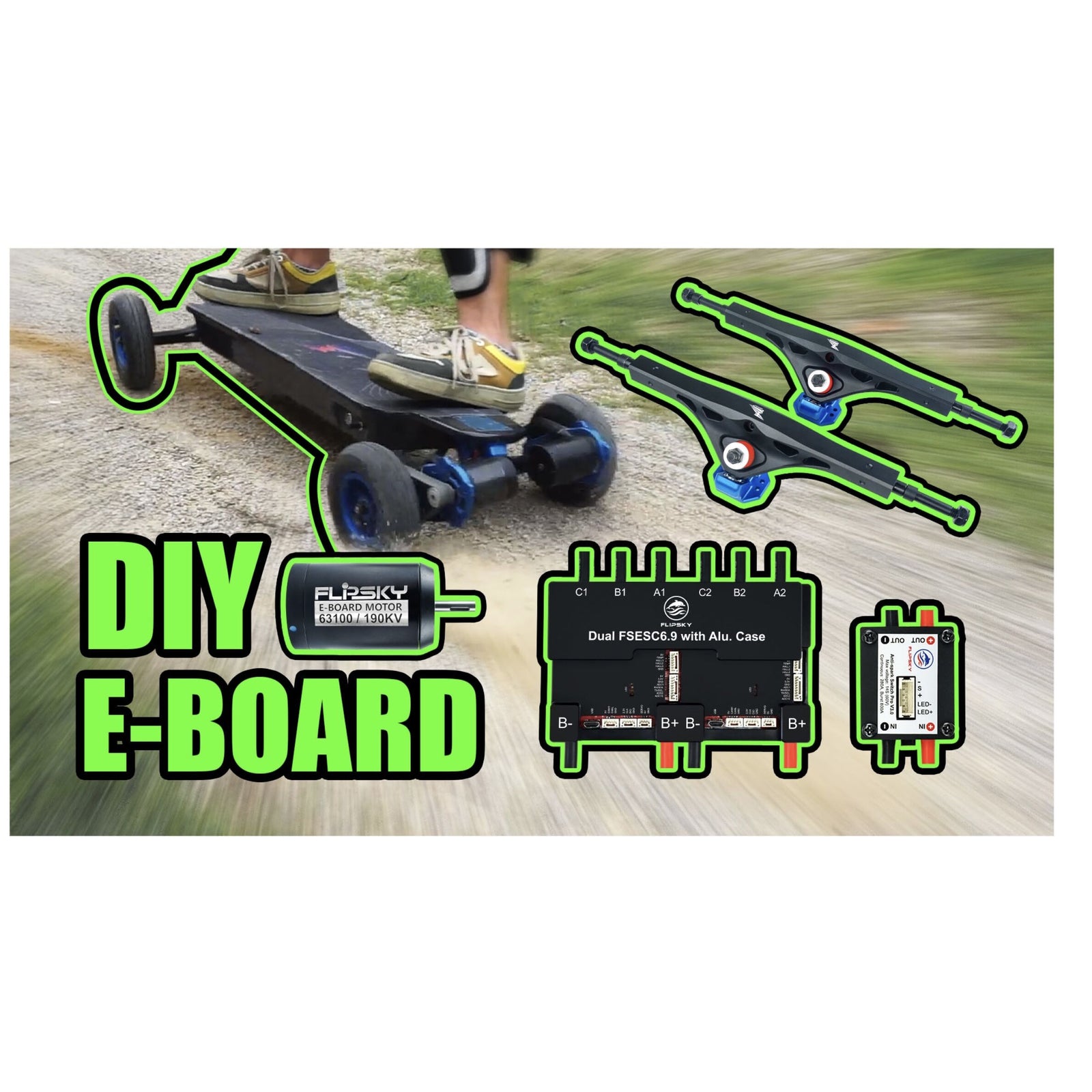How To Build a DIY Electric Skateboard?

Have you ever built your own DIY electric skateboard but met with some difficulties without the detailed tutorials? In this article, we will introduce the necessary components and give some advices for the DIY setup, and explain how they work together to create a functional and powerful electric skateboard.

What Parts Do You Need to Build Your Electric Skateboard?
Part I: Non-electronical / Mechanical Components
1. Deck
The deck is one of the most important parts of an electric skateboard. As the main part that supports the weight of the rider and bears the pressure of riding, the deck needs to be strong and durable enough to ensure the safety of riding. When choosing a deck, you need to consider the following factors:
- Size: The deck should be proportional to the rider’s body size. Personally, I would recommend longboard decks instead of other decks which gives you more stability, a smoother ride, and more space for components.
- Structure: The deck can be made of various materials such as wood, bamboo or carbon fiber.
- Requirements: Different decks have different advantages. Small decks are lighter and easier to turn, while large decks are more stable and can reach higher speeds. If you want to build off-road boards, you need to choose arched and more flexible decks.
2. Trucks
The trucks are attached with the wheels to the deck and allow the skateboard to move.
When choosing trucks, you will need to consider the following factors:
- Hanger width: The hanger width is the distance between the two trucks. It should be matched to the deck width.
- Angle: The angle of the truck can be changed to adjust the turning radius of the skateboard.
- Trucks type: The baseplate type determines how the trucks are attached to the deck.
In previous blogs, we have published the contents of Trucks Guide. Welcome to check it out, and I believe it will be helpful to your choices: https://flipsky.net/blogs/vesc-tool/truck-guide-how-to -choose-your-esk8-truck
3. Wheels
The wheels are what provide the movement and grip for the skateboard. When choosing wheels, you will need to consider the following factors:
- Axle diameter: The axle diameter of the wheel should be matched to the truck. As for players who are trying DIY for the first time, the Trucks Group Kit is the most convenient choice.
- Size: The size of the wheel determines the passability. Generally speaking, the size of the wheel determines the height of the skateboard from the ground. If your riding environment is not particularly flat and slope-free, it is not recommended to choose small size skateboard wheels.
- Width: The width of the wheel affects how much surface area is in contact with the ground. Wider wheels will have more grip, but will also make the board slower and affect cornering agility.
In my personal experience, a relatively large diameter and about medium softness to give a smoother ride.

Flipsky 16.3" CNC New Upgrade RKP Trucks Kit
Part II: Electronic Components
1. Battery

The battery powers the skateboard. When choosing a battery, you will need to consider the following factors:
- Type: The type of battery affects how long it will last and how powerful it is. There are three types: lead-acid, nickel-metal hydride, and lithium-ion. Lithium batteries are the most commonly used battery type for electric skateboards due to their longer battery life and larger discharge range.
- Capacity: The capacity of the battery determines how long it will last.
- Voltage: The voltage of the battery determines how many batteries are needed to power it.
- Weight: The weight of the battery affects how much the skateboard weighs.
2. BMS
 Flipsky BMS 14S LiFepo4 Li-ion
Flipsky BMS 14S LiFepo4 Li-ion
The full name of BMS is Battery Management System. It is a device for monitoring the status of energy storage batteries. It is mainly to intelligently manage and maintain each battery unit, monitor the status of the battery, prevent the battery from overcharging and overdischarging, and prolong the service life of the battery.
When choosing a BMS, we need to pay attention to the specifications, dimensions and functions of the BMS. Take Flipsky BMS 14S LiFepo4 Li-ion as an example:
- Size is 121*50*12.8mm, Net weight: 244g. The flat design can be suitable for most battery packs and will not add too much load to the electric skateboard.
- Specifications: Battery pack for 8S-14S, Charging current: <60A, Discharge current: < 150A
- Functions: Overcharge protection, over-discharge protection, over current protection, balanced protection and temperature control protection, which can meet almost all needs of skateboarders to protect the battery pack.
3. ESC
 Flipsky Dual 75100 With Aluminum PCB
Flipsky Dual 75100 With Aluminum PCB
Electronic Speed Controller (ESC) is the brain of your electric skateboard. It’s a piece of part that sits between your motor and your battery, with the purpose to vary an electric motor’s speed and be used to accelerate or brake an electric skateboard. ESC dictates how much power you want to send from your battery to your motor via some type of input, usually a wireless remote controller.
The type of ESC used by Flipsky is VESC®, VESC® was a type of ESC specifically designed for electric vehicles like the Eskate. It was designed by Benjamin Vedder, an engineer from Sweden, and hence the name, Vedder ESC.
VESC is excellent because it allows to customized settings and set parameters per your requirement. It allows you to control the torque of the board by adjusting the current output to the motor and current input from the battery. It allows you to customize the acceleration and braking curve so that the board behaves exactly as what you want it to while braking and accelerating.
When choosing an ESC, you need to consider the voltage and current it can withstand to not damage your build due to overload.
You can also set some limits to protect your ESC, motor, and battery such as:
limit the currents to the motor (overcurrent to the motor fries it).
limit the temperature of the VESC (going too hot may cook the VESC).
limit the minimum voltage to drain the battery (over-discharge degrades the battery).
4. Motors
 Flipsky Outrunner Brushless DC Motor Battle hardened 7070 110KV 4200W
Flipsky Outrunner Brushless DC Motor Battle hardened 7070 110KV 4200W
The motor is the heart of the electric skateboard drive system, which provides power to the DIY skateboard.
There are many different types of motors on the market, among which brushless DC motors are the most popular among DIY builders. BLDC belt motors are motors which are mounted to an electric skateboard that runs a belt between two pulleys (one on the motor pulley and the other on the wheel pulley).
If we choose belt motors to our DIY electric skateboard, we need to choose the compatible motor mounts according to the size of the motor. This part plays the role of fixing the motor on the trucks.
If you want to learn more info about motors, you can check out our previous blog: How to Choose Motors for DIY Electric Skateboard BuildingRemote
5. Remote
The remote is used to control the speed of the electric skateboard. You will need to consider the following factors:
- Grip style: There are three types of grips commonly used in remote control skateboarding: palm, finger, and thumb. Different boards support different grip styles, so please make sure that it has the proper size and shape for your comfort.
- Control type: Common remote controllers on the market have two modes: PPM control and UART control. You need to consider about the type of remote that can be compatible with your ESC.
Flipsky's VX4 remote control supports PPM control, UART control and also supports the joint control modes of PPM and UART, providing you with more choices.
6. Antispark Switch
 Flipsky Anti Spark Switch Smart V2.0
Flipsky Anti Spark Switch Smart V2.0
The anti-spark switch is used to protect the components of the ESC. Specifically, it is used to protect the power contacts from being burned and oxidized by the spark generated when the power line is connected or disconnected. Anti-spark switches can effectively prolong the service life of electronic products.
Based on the basic function of protecting ESC with anti-spark switch, Flipsky designed an upgraded smart version. Both the smart anti-spark switch V1.0 and V2.0 have a smart switch mode that allows your board to slide turnon and turn off automatically after 5 minutes of inactivity.
Now that you know about the different components of an electric skateboard, it’s time to build your own! Here is a step-by-step guide:
- Choose the kit (components) that is right for you.
- Assemble the kit (components) according to the instructions.
- Connect the battery to the electric speed controller and motor.
- Attach the deck and trucks to the motor and controller.
- Test the skateboard by riding it (Be sure to wear a helmet and protective gear to test on a safe road).
- Make any necessary adjustments.
- Enjoy your new electric skateboard!
Check out the video to learn how to start building an electric skateboard step by step.
For more tutorials and new product introductions, please follow our social media:
https://www.youtube.com/c/FlipskyTech
https://www.instagram.com/flipsky_tech/
https://www.facebook.com/FlipskyTech













Leave a comment